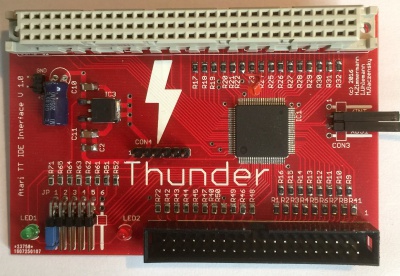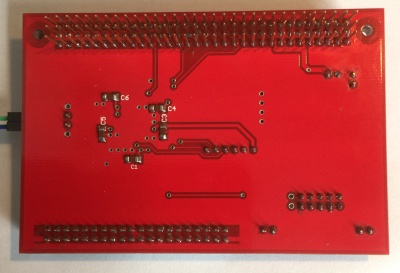Thunder IDE Interface - English Version
General
The "Thunder" is a unique interface for the Atari TT, which offers the possibility to connect IDE devices to the Atari TT. It is equal, if you use a hard drive, a CD-ROM or a CF card. Usable master / slave IDE to CF adapter or even IDE to SATA adapter can be used. Even SSD devices now works with the Atari TT. The Thunder is a partial plug and play solution. The extension card is plugged onto the TT-RAM socket of the Atari TT (internal slot in front of the power supply, 96-pin connector). It is only necessary to connect the Thunder with just two cables to the mainboard of the TT.
Features
- new development from the year 2016 (Pakman, Tuxie, Gaga)
- IDE interface for the usage with of 1 or 2 IDE devices (master / slave)
- 100% compatible with the Atari Falcon IDE bus
- currently up to 5.75 MB / s transmission rate (tested with CF card)
- special support from the HDDriver from version 10, with which the driver can be loaded into the Fastram and the transmission rate can be accelerated enormously
- Protection of the TT bus against overload caused by buffered data, address and control lines
- compact design, only 7.1 x 9.9 cm, in SMD construction
- central element is a programmable logic block (CPLD) from Xilinx
- looped TT-RAM socket, which allows an expansion, for example the Storm or other TT Fastram cards
- compatible with other Fastram cards, even with those of Atari
- 3 operating modes selectable via jumper block: Falcon compatible (standard) / ByteSwap (ppera) / SmartSwap (PC an Mac compatible)
- also works in accelerated TT, thus further performance increase (tested with 20MHz bus and 40MHz CPU)
Description
On the Thunder, the 96pin FastRAM socket is looped up and a an coded 40pin standard socket for IDE devices.
The jumper block JP1 - 6 is also located at the bottom left (see jumper assignment).
The green LED1 signals the operational readiness. The red LED2 signals accesses to the IDE bus.
Con4 in the middle as well as the pins GND and + 5V on the upper left are for programming the CPLD - please leave unused and never connect!
Con3 on the right side connects the two signal lines / Int and XDS1 to the mainboard (see Installation).
On some Thunder there are small hardware patches; please leave so. As of Rev. C, it is also possible to route the LED2 "outwards".
Hardwarerevisionen und Firmware
Per Stand vom 15.09.2017 existieren 4 Hardwarerevisionen der Thunder, nämlich Rev. A (Prototyp), Rev. B (= V 1.0), Rev. C und Rev. D. Die verschiedenen Revisionen haben dieselben Features und unterscheiden sich lediglich geringfügig im Aufbau, nicht aber in der Funktionsweise.
Per Stand vom 05.08.2017 ist folgende Firmware aktuell: 363. Diese Firmware ist im Timing verbessert, da es einige sehr wenige TT gibt, bei denen es genau darauf ankommt und die Funktion erst mit dieser aktuellen Firmware gewährleistet wird. Die verwendete Firmware ist meist hinter auf die Thunder geschrieben. Ein Update ist möglich. Thunder mit älteren Firmwareversionen benötigen kein Firmwareupdate, wenn es bisher keine Probleme gab.

